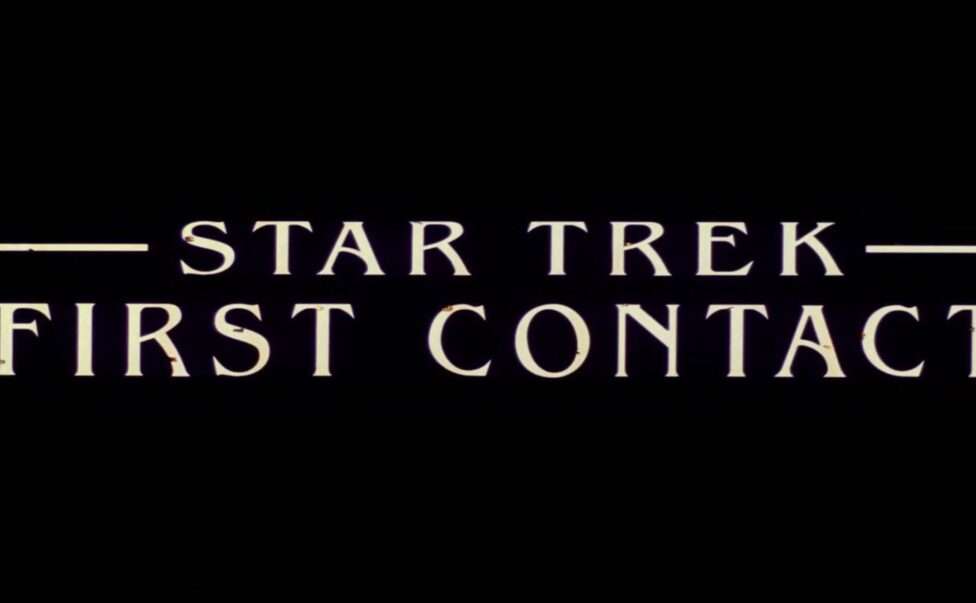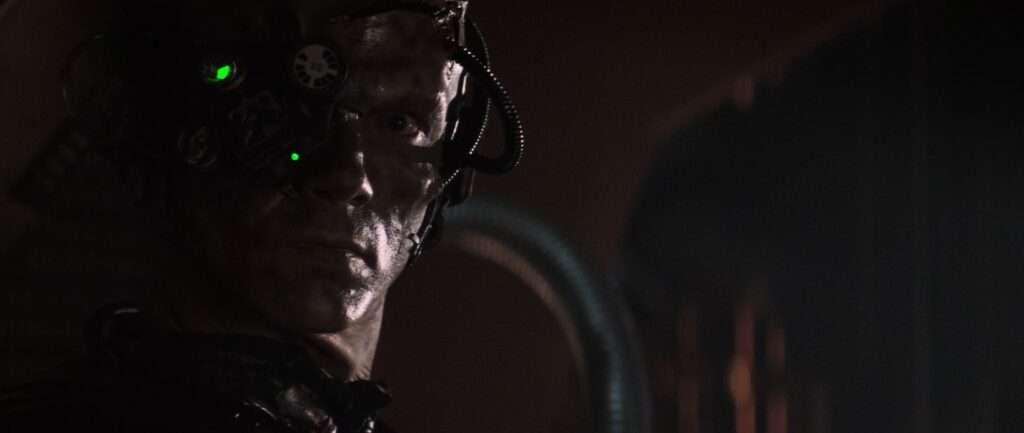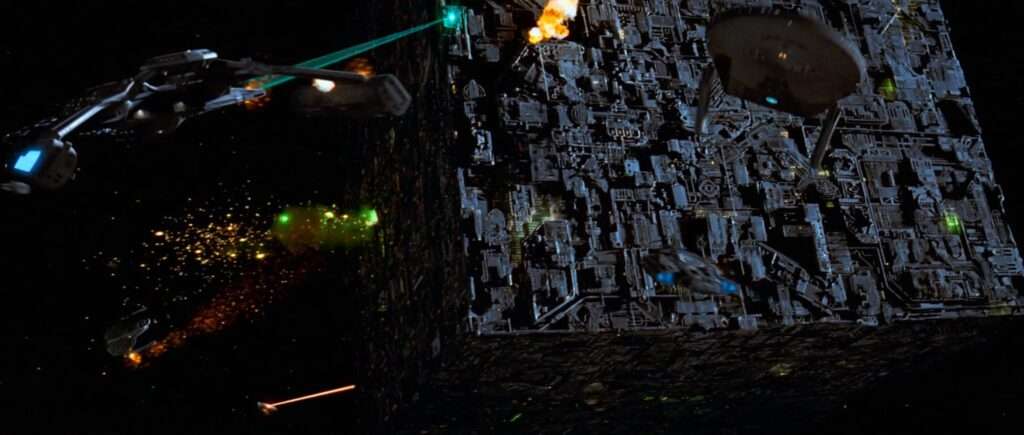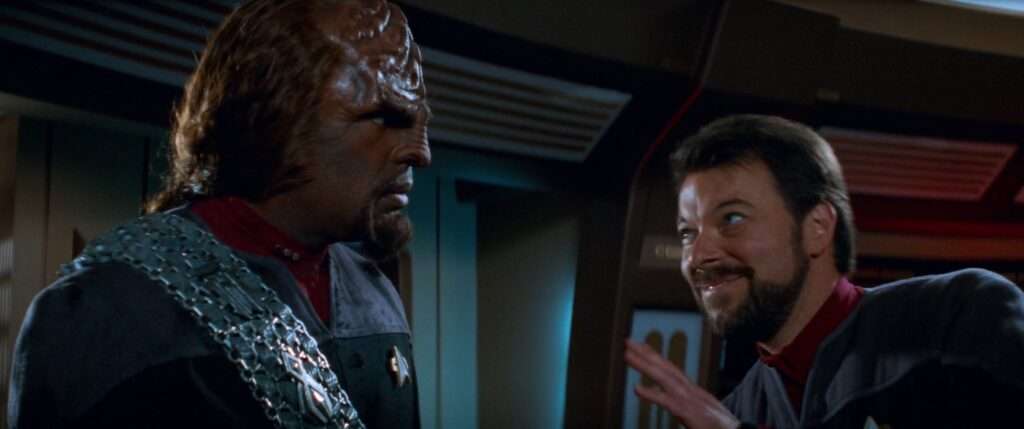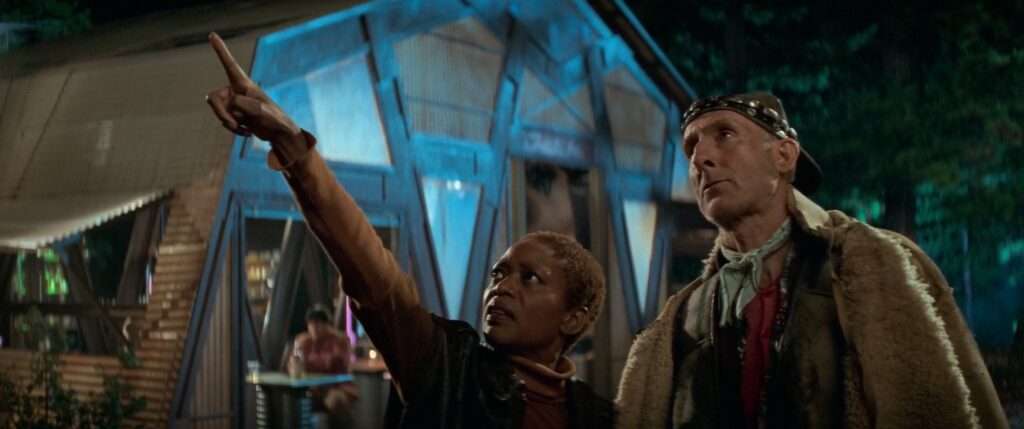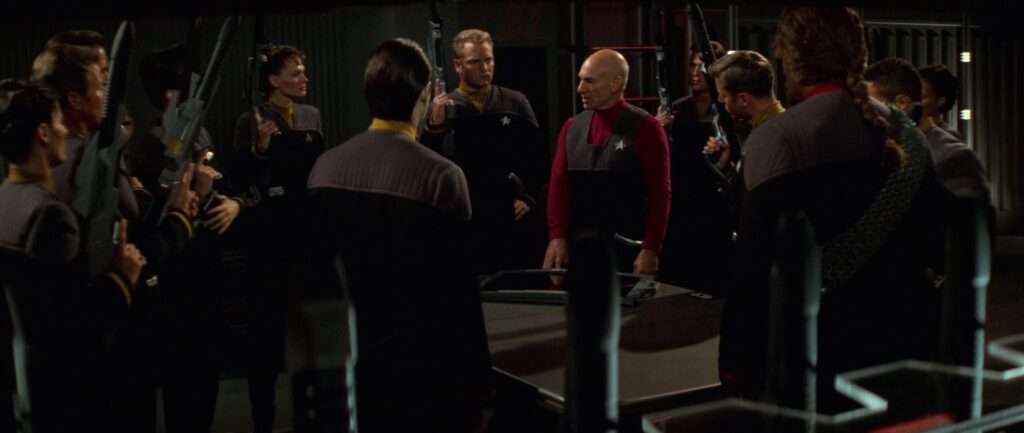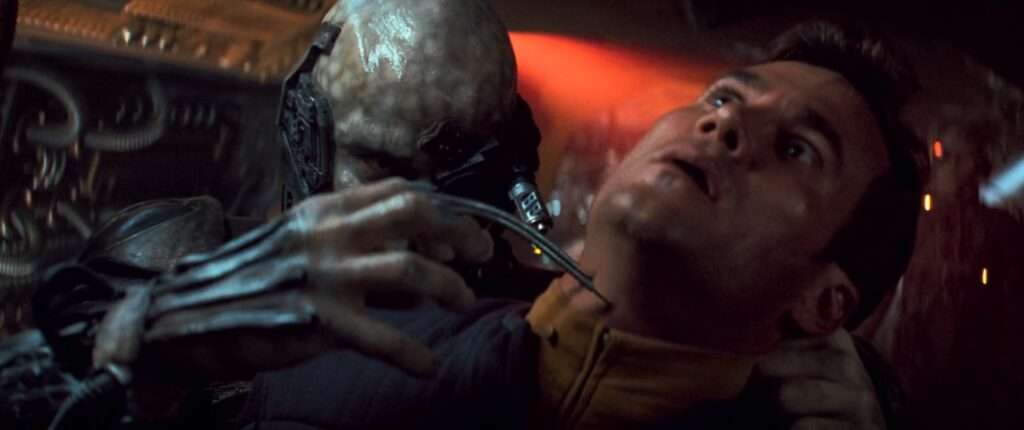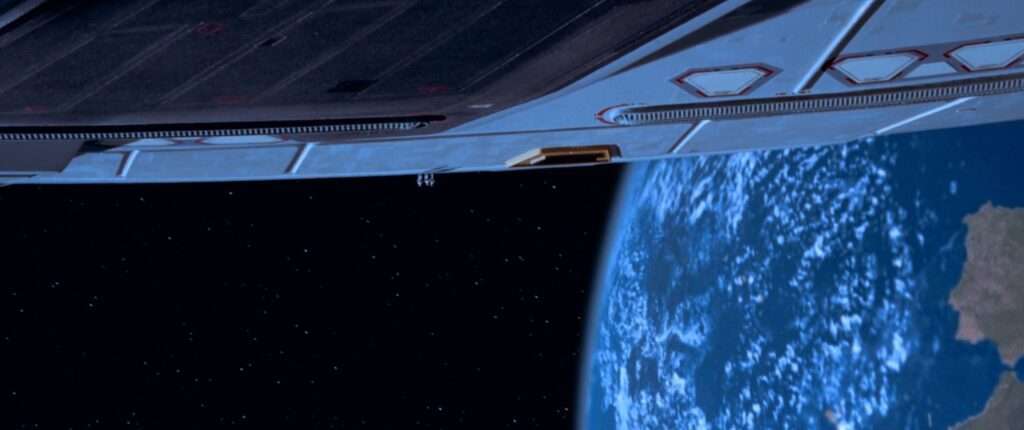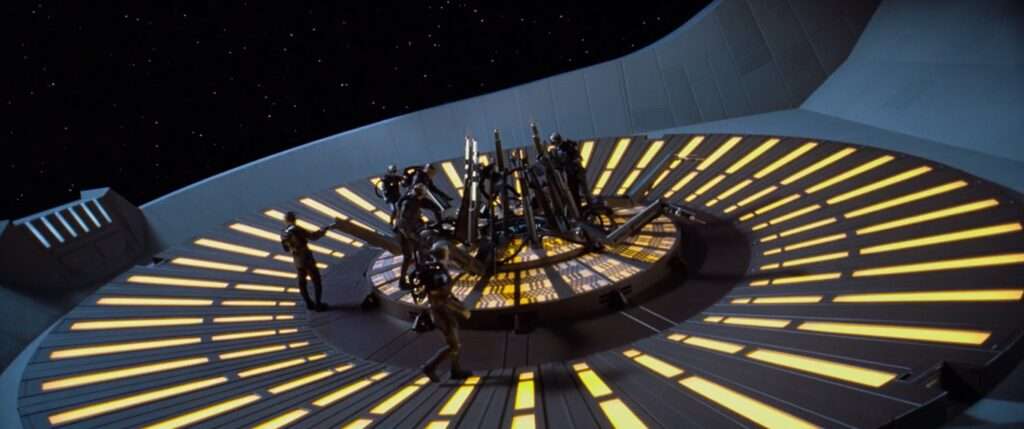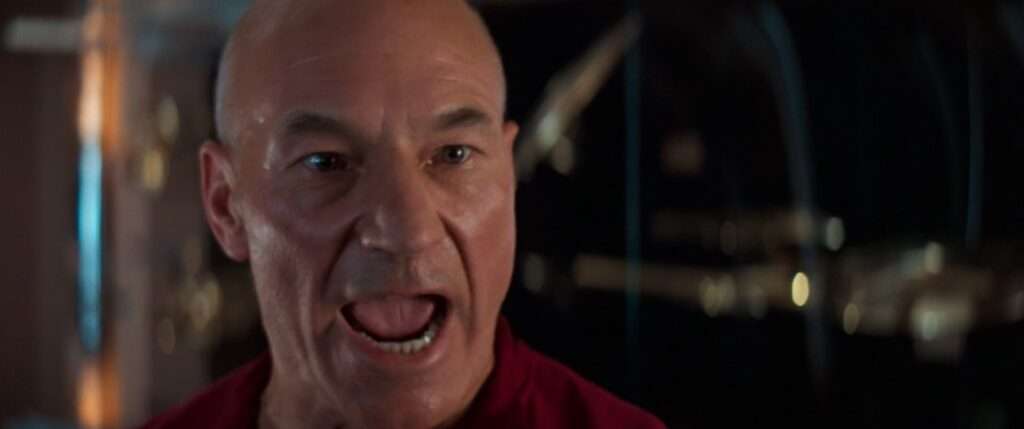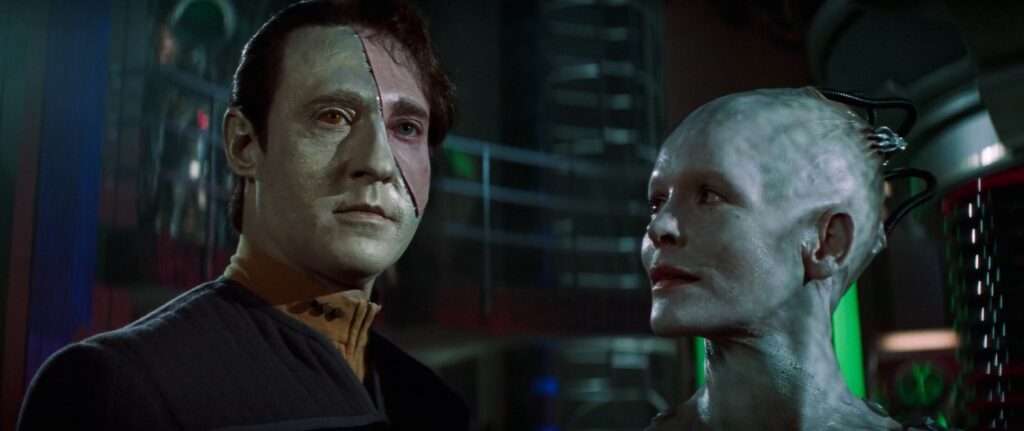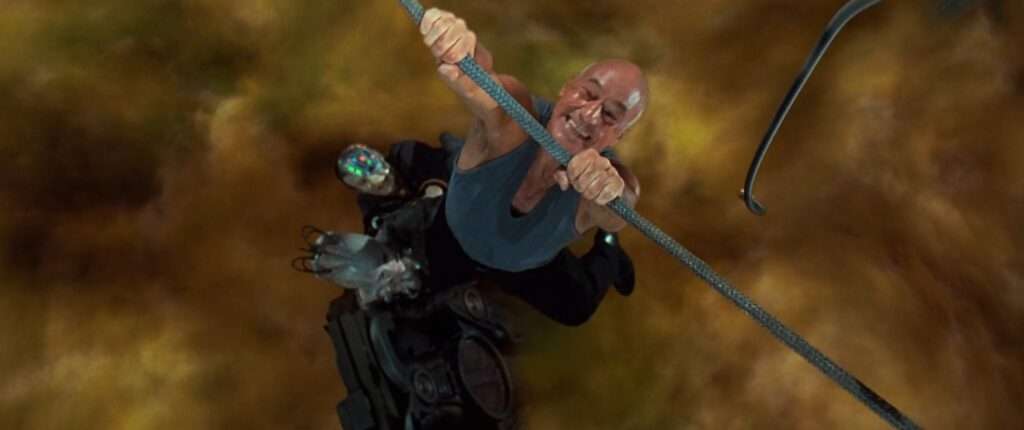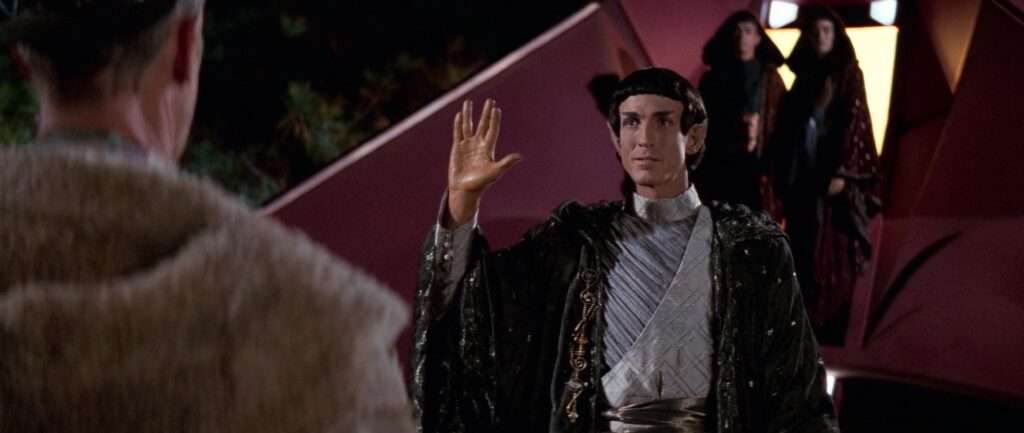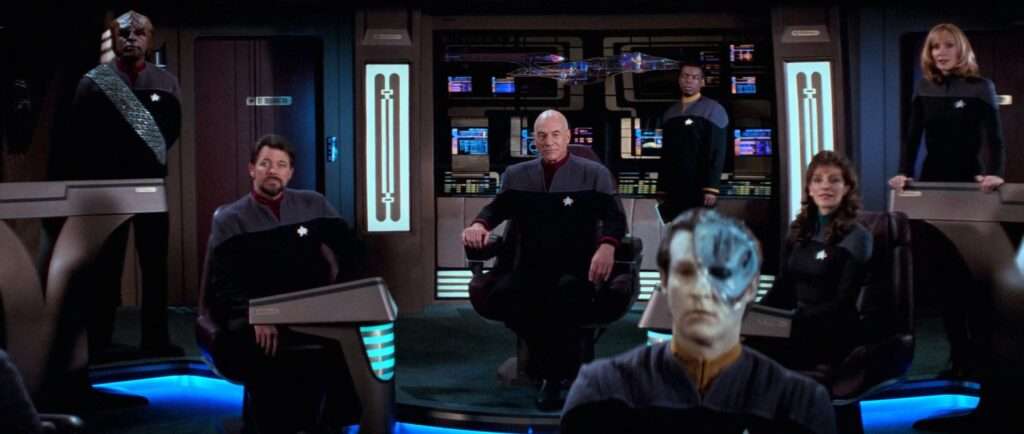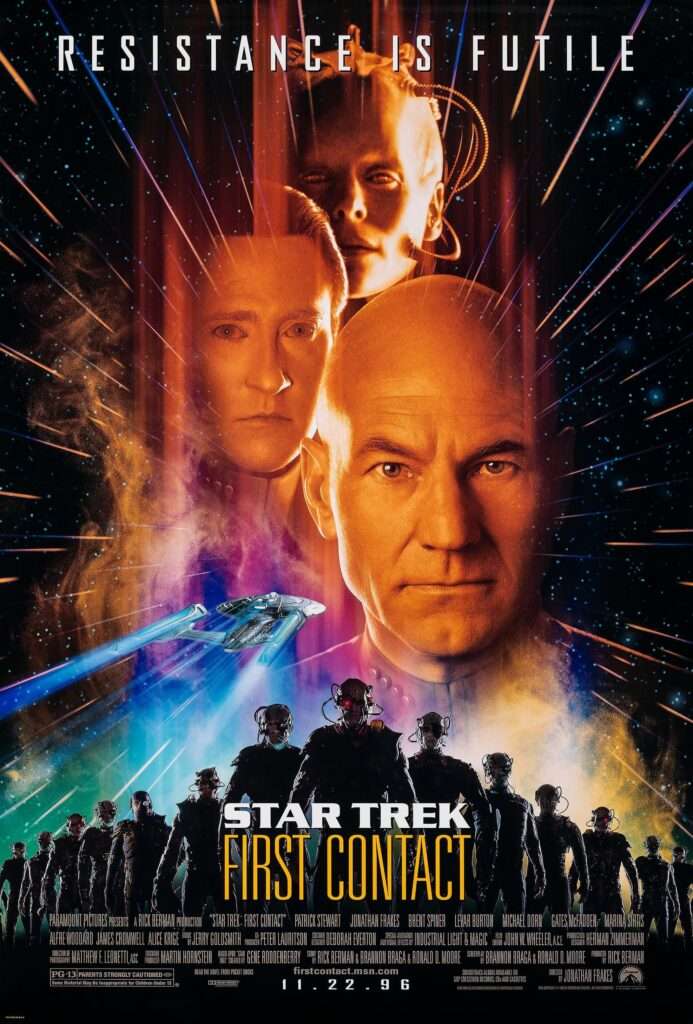Star Trek: First Contact
After the success of Star Trek: Generations, another Star Trek film was put into production in short order. This is the first Trek movie that’s solely the Next Generation crew – it didn’t have the crutch of Kirk and other TOS characters like the last film did. Not that they really needed it, but this is their first solo film. For that what do you do? You bring back one of the best villains from the TV show – the Borg.
They of course got a visual upgrade as you couldn’t use the TV version of the Borg in a major theatrical film, they’d look too shambly. The upgrade was not referenced on screen, you’re just supposed to think they’re the same, and that’s fine – no harm here. They look better than they did on the TV series (which was pretty good anyway).
This film came out about a month after my wife and I got married, and was the first new film we saw together as a married couple. It won’t be our last (and I have a GREAT story about the JJ Abrams 2009 Star Trek film to tell when I get there), but I have strong memories of taking my new wife to see this, and she loved it too. While not quite the crossover masterpiece that Voyage Home was… First Contact works surprisingly well for those who aren’t locked in to all the Trek minutae from the past. Everything you need to know in terms of continuity from the past is explained on screen (a lot of that is Picard and being captured by the Borg), but done in a way that they don’t feel like they’re stopping the movie to go “You need to know this!” It works quite well, and even the fact there’s a brand new Enterprise here (NCC-1701E) is mentioned, but they don’t spend a ton of time on it, so it’s acceptable to new people, and not something thrown in just for the hardcores. It’s a masterful balance of both geeky and wide audience – a lot of that has to be down to Frakes himself as well as the script. At this point in his career Jonathan Frakes has directed a lot of Star Trek. He directed 8 episodes of his own show, then did 3 on Deep Space None, and 3 on Voyager, all before this movie was filmed.
There are a lot of other people in this film from other Trek franchises and some from here that turn up elsewhere. Given I don’t want to stop the review for that, I’ll list them all here. I ended up writing a longer version of the “Facts” that I wrote for all the episodes in the past, but there’s so much of it. :)
- Alfre Woodard plays Cochrane’s assistant Lily Sloane. She later reprises this role in the penultimate episode of Star Trek: Lower Decks – “Fissure Quest” (2024).
- Alice Krige plays the Borg Queen here. She later reprised this role in a few places. She did it in the final episode of Star Trek Voyager, “Endgame” (2001) and then in two episodes of Star Trek Picard (“Vox“, “The Last Generation” (2024). The character was also played by another actress in Voyager in three other episodes (Susanna Thompson).
- James Cromwell played Zefram Cochrane, the inventor of warp drive. He would reprise this role in the pilot of Star Trek: Enterprise, “Broken Bow“. He would also appear in the fourth season episode of Star Trek Enterprise “In a Mirror Darkly, Pt 1“, but not in newly filmed footage. They re-used a scene from this movie in that episode.
- Dwight Schultz reprises his role from the series as Reginald Barclay, but it’s not the final appearance of the character, he returns in later seasons of Star Trek Voyager as well.
- Ethan Phillips who is well known as Neelix in Star Trek Voyager had a cameo here as a maitre’D in the holodeck scene, but he is uncredited.
- Robert Picardo who played Voyager’s EMH, plays a different EMH here – the one for 1701-E in a comedic cameo when Crusher speaks him into existence.
- Patti Yasutake makes her final appearance in the franchise as Nurse Ogawa.
- Don Stark plays a character called Nicky the Nose – also from the holodeck scene. He also appeared in a Deep Space Nine episode “Melora” as Ashrock the Yridian.
- Jack Shearer plays Admiral Hayes here, a role he would reprise in the Voyager episodes “Hope and Fear” and “Life Line“. How he escapes the destruction of his ship in this movie is never revealed.
- At this point in the overall franchise continuity, Worf was already an established regular on Deep Space Nine. The excuse he has to be here is that DS9 sent the Defiant to fight the Borg and as such Worf was in command of it.
- I’ve read rumors that Nichelle Nichols & Kelsey Grammar are also in the movie as uncredited voice cameos, but I can’t find any proof of that.
- One of the secondary characters is an actor I know from elsewhere. Neil McDonough played a Lieutenant Hawk who eventually gets assimilated by the Borg, but not before being part of the bridge crew. I know him well for the character of Damien Darhk who appeared in many series in the CW’s “Arrowverse” universe of shows. In all he played the character in 24 episodes of “Arrow”, 4 episodes of “The Flash”, and 21 episodes of “DC’s Legends of Tomorrow” (plus several others where he’s name dropped).
- When Cochrane’s ship gets into space and extends its warp nacelles, that sequence is used in the title sequence of Star Trek: Enterprise when it shows the evolution of exploration from sailing ships to starships.
A few fun facts:
- The original name of this film was “Star Trek Resurrection”, but when Fox announced the title of the fourth Alien movie as Alien Resurrection”, they had to change the name of this movie.
- It is the first Star Trek film to be rated PG-13.
- It was the first film since the original one not to re-use any footage from another Star Trek film.
- The events of this movie are referenced in the DS9 episode “In Purgatory’s Shadow” as well as a couple of episodes of Voyager (“Year of Hell Part II” & “Relativity“). The crashed Borg ship in this movie was recovered in an Enterprise episode called “Rengeration” and the aforementioned events of “In a Mirror Darkly” also reuse footage from this movie.
- Deep Space Five gets mentioned – seems to be mentioned more than another of the other stations besides DS9. :)

The Movie
Now that I’ve written over a thousand words in the intro, I should probably get to the movie. One thing about the opening, there’s nothing in it, it just starts with the title, and a cloudy blue background for the titles. No plot, nothing. We get to hear some great music by Trek veteran Jerry Goldsmith who has done a lot of Star Trek movie music. Good stuff for sure.
The movie gets right into the Borg stuff from the start. We get a flashback to Picard being captured back in TNG. While his uniform is period active, the Borg ship and the Borg themselves look much different – just one of those things you have to overlook. It’s got a great visual starting with a closeup of Patrick Stewart and pulling back fully to reveal the scope and size of the Borg ship. It shows stuff from his original capture that we never saw before – the fact this is a movie is used instantly when it’s shown what looks like a drill about to go into Picard’s eyeball, but they don’t dwell on that for more than like two seconds (nor is it gross, just makes you think it will be). Turns out it’s all a dream of Picard’s and that it immediately establishes the Borg as a thing in this movie if for some reason you had no idea they were going to be in it from all the pre-movie press. Very well done opening, IMO.
We very quickly get into Borg battle stuff – there’s little time for any of the usual niceties we got on the TNG series – this is definitely a movie pace. It’s not written like an episode on the big screen (that happens in the next movie). We also get an example early on of how Data’s struggles with the emotion chip from the last movie have been figured out. He still has the emotion chip, but it’s not something that is a problem for him. Early on when Picard says he’s violating Starfleet orders and joining the battle, Data says “I believe I speak for everyone when I say “To hell with our orders””.
During the battle we get Worf and the Defiant show up to battle the Borg. That’s how we get Worf over from Deep Space Nine to be back with his Enterprise crew. In the original remit on Deep Space Nine for the creation of the Defiant, it was said it was created to help battle the Borg. But this is the only time we actually see it battle the Borg – that never happened on DS9. Over there, it was just a way to get the people off the station for more traditional “starship stuff”. One other fun thing – in the scene when Worf is on the Defiant mid battle we get a reuse of some of the music from the original movie. That movie starts off with a scene where a couple of Klingon ships battle V’Ger. The music there is quite epic, and since Goldsmith did that movie and this one, he reused his Klingon music. My brother and I always called the “Mad Klingon Music”. This stuck out to me on first viewing and was a major musical highlight for me in this movie. The Defiant is damaged, but salvaged – and its crew (including Worf) is beamed to the Enterprise, which explains Worf hanging around for the rest of the movie.
In the battle, the Borg ship is damaged to the point where it is destroyed (due to I presume the excessive amount of ships attacking it), but in the moment before it explodes a shuttle escapes – a Borg sphere (that’s new). The sphere opens a portal into the past, and has changed events to the point where Earth has 9 billion Borg on it. The Enterprise caught in the temporal wake of the sphere follows it back to Earth and destroys it, but some Borg have beamed to the Enterprise and start assimilating it. This sets off the main plot of the movie, and already dealt a heavy amount of well paced action which tells you all you need to know with no gaps in info. All of that in the first 13 minutes of the movie (including opening credits).
This sets off the primary plot of the movie that the Borg have gone back to the date of First Contact – the first time the Vulcans encounter Earthlings as they are in the area, and spot Cochrane’s warp test flight. The Enterprise crew basically make it their mission to help that flight go off, or it will change the entire future of everything. Pretty standard sci-fi trope – time travel changes events, but our heroes are immune to the changes due to some timey-wimey bullshit. :) There actually was one funny little bit in this exchange which was a nice use if humor. When Worf says he’ll help on the Enterprise at tactical, Riker teases him about whether he remembers how to fire phasers. That was a funny bit – there’s not a ton of that in this movie but when it is wielded, it’s quite effective. It did bring up a minor nit, since this is a completely new ship, Worf acts like he’s handled the controls all his life. That always made me go “eh”, but a very minor quibble.
Once the Enterprise crew realizes the date they landed, they make it their mission to find Zefram Cochrane. This is a problem because before the Enterprise destroys the Borg sphere, it attacks the settlement that Cochrane and his assistant Lily were at. Most of the area is destroyed or damaged, including the rocket used to make the warp flight. That’s what the crew needs to do. Find him and help things come off the way they’re supposed to. It’s not easy as once found he just wanted to drink himself into oblivion and didn’t care about the experiment. They’re attacked by Lily and in stopping that there’s a funny scene with Data making a huge jump over multiple levels of the building. It requires her to be taken to the Enterprise for medical assistance.
The rest of the crew beams down in a search for Cochrane. There’s something for mostly everyone to do, although Crusher is mostly stuck on the ship being a Doctor – no wild adventure for her (at least not in the first part – she is barely off the ship in the entire movie).
Back on the ship, the crew is trying to figure out what’s happening with the environment, it makes for some good drama as people are being picked off. Has a little touch of Alien to it, when people are being assimilated one by one on a spaceship. Picard & Data return, because Picard can hear the Borg, and realizes what’s happening from the planet. It’s an interesting shortcut for things that would normally require exposition to get across in the story – having Picard be able to “hear” the Borg in his mind. He goes back to the ship right as the Borg start taking over everything, it’s some good drama. It’s some good acting by Patrick Stewart (no surprise there) as he’s already figured out in his head exactly what is going on. While he’ll fight the fight, he also has a sense of impending doom – a new angle for Picard, in some ways his portrayal conveys thoughts from the character that he thinks he’s already lost. It’s a different look for Picard, since he always assumes he’s winning. AS the Borg are taking over the ship, and Crusher has to evacuate sickbay, we get the Robert Picardo cameo as the Enterprise’s EMH (not the same one from Voyager). Was an amusing appearance by him trying to talk a bunch of Borg into not chasing after Crusher and crew. In the escape, Lily escapes from Crusher.
Once Picard tries to fight the Borg he becomes much like Khan was in the second movie – completely driven by revenge, out to stop them any any cost. This manifests itself as him sending an army against them (see the screenshot right above this text), and then falling back, to untaken parts of the ship, even trying to use the Holodeck as a diversion to stop Borg (which has the other Voyager cast member cameo – Ethan Phillips). He gets called out on this later by Lily, but it’s interesting to see him driven in this way, it’s a version of Picard we’d never actually seen before. He even calls Worf a coward at one point. In this battle for the ship, we get another reference to Data’s emotion chip. He tells Picard he’s scared when they’re searching to which Picard tells him to just turn it off for now, which he does. I did like they took a moment to disable it because clearly Data is in scenes where his emotions should cripple his actions. That comes back a little later though.
Back on the planet, the crew’s cover was almost immediately blown once they start looking for Cochrane. It led into one of the funnier scenes in the movie when they finally make contact with him, it involves Cochrane and Troi drinking in a bar. Troi drunk is a hilarious af scene. Some say it’s totally out of character, but I didn’t have a problem with this. It’s VERY in line with the character of Cochrane as portrayed in this film. They have to tell Cochrane the truth, and he reacts poorly. He is super doubtful of all of it and doesn’t want to believe it. In this sequence Cochrane utters the words “Star Trek” – which at this point were the first time in the franchise anyone has ever said “Star Trek” on screen. He does eventually agree to do it, but eventually gets overloaded when people start saying too many things from the future (Hello Reg Barclay cameo – although it’s Geordi who ultimately blows it). Cochrane runs off because everyone knows him as a legend, and he can’t deal with it – he has to be phasered to get him to stop.
The battle on the ship continues, and finally get to see the Borg in all their redesigned glory about 35 mins into the episode. They’ve taken over engineering, and in a fight Data is captured, although we don’t immediately know why. In regrouping, Picard runs into Lily who takes him hostage when trying to escape. In resolving that conflict, Picard shows her Earth from space, which disarms her (literally too). Picard must like doing this because he’s shown planet natives their planet from space about half a dozen times if you count all the TNG episodes. Anyway, Lily finally comes to the conclusion they’re not there to kill them. We get some on screen dialogue that there’s no monetary system in place – that humans don’t use money anymore. I’d love for that to happen, but I can’t see that with how money and power driven our culture is in real life, but I digress. Data’s been captured by what we find out is the Borg Queen – a new concept. This was primarily done because the Borg as we know them to this point were just a faceless group of characters. They tried it once with Picard as Locutus, but after him they needed a new focal point. The Borg as they are by default are just mindless robots, you can’t reason with them you can’t bargain – but giving them someone who is more an “individual” while still being part of the collective is a different dynamic. I think if they invented the Borg Queen in the series, it might have come out differently. From what I can gather from story point the Borg Queen came into being because this was a movie. They needed something for audiences to focus on, not just the Borg rampaging through everything. She re-activates Data’s emotion chip and teases him with making him human even giving him a section of actual human flesh on his system. Her goal is to create a companion for herself in Data. For a time it looks like she succeeded. We even get a mention of Data being “fully functional” (memories of Tasha Yar). In some ways the Borg in this movie remind me a bit of the Cybermen in Doctor Who (especially the 1980’s versions). There’s a Cyberleader who is the focal point of all the talking, and the “rank and file” Cybermen are just there to either be cannon fodder, or fill out a scene.
As we go through the ship, we run into quite a few Enterprise crew who have either been fully assimilated, partially assimilated, or have just been. Picard killed one of the later when he begged for help. Some of the partials have things like their hands amputated (we don’t see that HAPPEN, but we see the result), we see them with various eye implants. It’s not gory, but definitely something that wouldn’t have happened on the TV show for sure.
There’s a lot of dialog between Data and the Borg Queen once she’s revealed. I need to take a moment and talk about the actress playing her, Alice Krige. She brings a sensual performance to the role. While nothing she says is sexy in any way (well, maybe one small part), her delivery is whispery, almost sexy, like the way a woman would talk when fully stimulated sexually. But again, there’s nothing sexual about her character or her performance in that regard. It’s just the way Krige delivers her dialog. It’s an interesting dynamic, especially after she forcibly turns Data’s emotion chip back on. She seems to play on a set of emotions that Data hasn’t experienced, manipulating him in that same kind of sensual voice cadence she uses. It’s a pretty cool scene – by traditional sensibilities, one could call it a torture scene… Data is tied to a table being manipulated both emotionally and physically – yet nothing about it played out like a standard torture scene would). If anything it’s quite the opposite. When she shows that Data has organic skin grafted onto him, the Queen blows air on the hairs, which stand up sending Data into an emotion that we’ve never seen before. The sexiness plays out when she asked him “Was it good for you?”
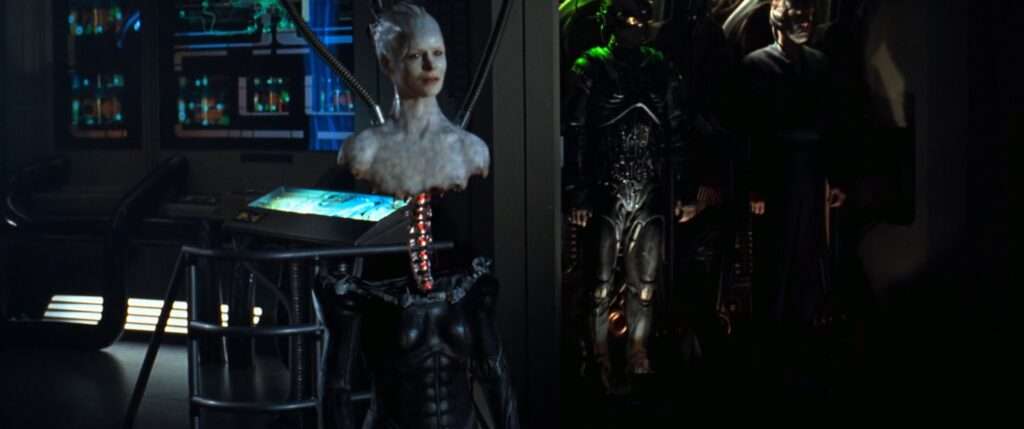
As Lily and Picard are going through the ship, he’s telling her about the Federation, she’s coming around to think t hat things aren’t so bad, but she’s seeing mostly this driven version of Picard. She doesn’t know what he knows about the Borg. When we get to the holodeck scene, Picard kills one of the Borg that used to be a crewman (Ensign Lynch) with a bloodlust that we don’t see from this character. It scares Lily who is witness to it. Picard kills him and then reaches into his body to remove something he can use to track the Borg – all info he would know from his assimilation, but Lily doesn’t know that – she just sees him as a heartless bastard. We also get to see some more of the POV of the Borg which I quite like. It shows things as a blue tinted fish eyed lens look where things are out of focus. You’d think the Borg could see better than that.
I actually have been finding it hard to write about this despite so many written. That’s because the two plots are distinctly separate from each other. Riker/Troi/Geordi/Barclay and other people are on the planet with Cochrane. Kirk, Lily are on the Enterprise with Worf, Crusher and Damien Dhark (ha). They don’t interact with each other. Both drive the plot, but they spend 5-10 mins on one, jump to the other. I get why they do this ,but it’s hard to write about parts of the story because then the next one interferes. But if you see the movie, it flows, but I feel my writing is a bit disjointed.
There was a major change to the character of Geordi in this movie. He no longer has his visor. His eyes have been replaced with some sort of electronic thing – it basically allows LeVar Burton to act without the cage on his face, but still gives him access to things other people can’t. The thing is they just showed it there. They spent no time talking about it, we got a few closeups of Levar’s eyes when the “eyes” were doing something. It’s a pretty fundamental change to LaForge here, and they don’t spend any time talking about it. That’s both cool and surprising at the same time. It must have been a choice because stopping to talk about his not needing a visor anymore doesn’t really service the plot. But still to have ZERO mention of it felt a bit odd.
There’s a cool scene about an hour in where Picard, Worf, & Hawk are in space suits, and they for a walk on the outside of the ship to get to the deflector to stop the Borg. The scene with them on the outside of the ship is quite cool. In the end they’re successful, and I liked them coming up with an inventive way to get around the problem other than just crawling through another Jefferies tube to get to where they wanted to be. They”re ultimately successful, and there’s some good drama. Hawk gets assimilated while in the suit, and Worf gets his air line cut when they start fighting the Borg in zero gravity. They’re ultimately successful, but Hawk is lost. See ya Damien. n when he realizes that Picard will have the out in zero-g is a well acted bit by Michael Dorn. The visuals here of them walking on the outside of the ship are miles better than the last time that effect was shown in the first movie.
Ongoing torturing of Data from the Borg Queen involves her actually kissing Data and enticing him with a sexual encounter – but the scene is super short, about 2 mins. The cutting between plots is quickening now, spending less time on individual plot points. We had the Queen’s enticement, Picard/Worf on the outside of the ship, and then Riker & Geordi chasing Cochrane. All of that in the span of two minutes. It’s a change in pacing, the movie hasn’t moved this fast, makes you think something’s about to happen.
That something is that the we finally start to get a handle on the Borg with the aforementioned scene on the outside of the ship coming to a peak where they’re able to stop the Borg’s trying to build a beacon on the outside of the ship. Worf chopping a Borg in outer space with a knife was pretty Klingon. He gets the best lines with “Assimilate this” while blowing them up after they stop what they’re doing.
Once the Borg are stopped, they advance on the ship again, and things seem pretty hopeless. Picard refused to give up and is determined to find a way to stop them – that relentless determination like Khan pops up again. He’s ordering people stand their ground, who will likely be killed. An extra in one scene does some great acting conveying the fear and revulsion at the order he’s been given. Worf tries to defend him against Picard, where Picard calls him a coward for wanting to blow up the ship to stop the Borg. Picard refuses to accept and goes off to his ready room. Lily who has has no concept of this structure refuses to accept it. She goes into Picards’ ready room and f’in goes off him. Calling him out for the Ensign he shot up on the holodeck, yelling at him with “Where was your beloved sensibility there?” She even calls him Ahab at one point, which actually gets Picard’s attention. It then goes off into the most notable and well acted scene in the entire movie. When Picard’s rage finally comes out over his assimilation what the Borg are doing, etc.. It’s by far my wife’s favorite scene in the movie, and is a great Picard moment. Picard’s rage is manifest at a point where Lily tells him to “blow up the damn ship”. Picard screams NOOOO (much better than Anakin Skywalker did), and destroys the glass and some of the models there. He then launches into one of his top acting moments in a speech which I’ll just type here, because my words would be feeble compared to Stewart’s acting. “I will not sacrifice the Enterprise – we’ve made too much comprise already – too much retreat. They invade our space, and we fall back. They assimilate entire worlds, and we fall back. Not again. The line must be drawn HERE. This far – NO FURTHER. And I will make them **PAY** for what they’ve done!” The speech totally shuts down Lily as she goes quiet. The best part is that it wasn’t just Patrick Stewart – this scene doesn’t work without Alfre Woodward. She’s just as important to this scene. Calling him Ahab finally gets through to Picard – it snaps him out of it. He decides to blow up the ship once he realizes he’s Ahab. It’s a master class in acting tone and delivery by both of them.
One side note on this scene. Many years later when Deep Space Nine was winding down, the penultimate episode of the show (“The Dogs of War”) featured a scene with Quark. In that episode Quark is bemoaning changes in the Ferengi Alliance, and in that he utters these lines: “I won’t preside over the demise of Ferengi Civilization. Not me! The line has to be drawn here! This far and NO FURTHER!”. My wife and I were watching that originally when it went out and both of us busted out laughing. Right after Quark said that the next thing you saw was just an establishing shot for the next scene – it’s almost as they knew their audience would be laughing and gave them time to laugh through no dialogue. Both scenes were written by Ron Moore and I read a quote somewhere that he said he likes “sending up his own scripts”, well, that worked. :)
After that scene, we get a cool mix of the plots, because at the moment Picard and crew are issuing the self destruct sequence we’re getting the launch sequence down on the planet. I liked the way it brought the distinctly separate parts of the plot together without them directly being involved with each other.
The launch scene was funny when Cochrane couldnt’ find his audio recording to play and then he put it in there. Steppenwolf’s “Magic Carpet Ride” (and the real song too not some fake cover). It struck me as funny personally due to my own habit of playing Deep Purple’s “Highway Star” whenever I drove off the parking lot with a new car. It’s not the same without that tune – I get it. The launch is successful, a Vulcan ship lands on Earth, and history is saved, mostly ending this plot line of the movie – there’s no more surprise with the Cochrane story.
Back on the Enterprise the self destruct is activated, and Lily realizes that Picard wasn’t leaving with everyone else. That’s because he has to go save Data in Engineering. This brings us to the climax of the story where Picard goes to engineering to save Data, who initially looks to be fully converted – not to be a Borg, but to be a partner for the Borg Queen. The Queen refers to Picard as Locutus, never “Picard”. There’s some talking here where Picard offers himself as a willing companion to try and save Data. In fact it works, the Queen releases Data, but he doesn’t want to go anywhere, so Picard basically gives himself up for nothing. It is played that Picard has lost but the catch at the end is that Data was just pretending to acquiesce. A battle occurs and Picard does what was brought up in the earliest stages of the movie as a plan to defeat the Borg. If you shoot at a specific part of the engineering core it would flood engineering with a liquid which dissolves all organic material. It would wipe out all the Borg in the room. Picard escapes by climbing above it, and Data is unaffected except the human skin the Borg queen put on him. But the Borg Queen herself is destroyed (in this physical form). This shuts down the rest of the Borg in this area stopping them. The ship is never blow up because the Queen ordered Data to turn off the self destruct in the early parts of the scene in engineering. That was Data “proving” he was her servant. It’s here that we’re convinced (or at least I was) that Picard had lost because Data deactivated his encryption and gave the Queen computer control. Her first use of it was to make Picard watch as she was going to use th Enterprise to blow up Cochrane’s ship (finally bringing both plots together). They fire on the ship, and the moment the torpedo misses Cochran’s ship is the moment we know Data was faking it – so does the Queen. His delivery of saying “Resistance is Futile” to the Queen got applause in theatres in 1996 for sure. It was a surprise twist, although in the end you never figured Data would fully be evil. But I do confess I bought into it in the drama of that scene. From there the defeat of the Borg happened once and for all (well, in this movie – the Borg wouldn’t be ultimately defeated until a Star Trek episode in 2024).
So the meeting with the Vulcans happened as it should. Cochrane greeted them with a handshake, the Borg were defeated and the Enterprise was saved (although a lot of time will be needed at a Starbase to remove all the Borg material). The Enterprise returns to its own time and things happen as they were supposed to. Very clean ending. Can’t really think of any dangling plotlines in the story.
My Summary
- Biggest Problem: Some of the fast cutting of scenes I could have done without, but not a huge problem.
- Biggest Strength: The Borg. This works really well in a movie without some TV restrictions.
- Overall Rating: A
This was Jonathan Frakes’ first theatrical movie. You wouldn’t know it. Has some nice directorial choices in terms of camera placement and whatnot. The story moves at a brisk pace, but not so much so that you think they’re cutting things short. It was a great script with good acting and direction. Jerry Goldsmith is along to do another bang-up Star Trek soundtrack, so you can’t go wrong there. It’s easily the best of the Next Generation films by far. Other than the fast cutting of scenes at some parts, I had no problem with the direction here. Was a great movie, and a good one to show non Star Trek fans. You don’t need all the Star Trek jargon in your head to understand this – and I think a lot of that is down to the character of Lily who is “us” in this story – well acted by Alfre Woodward. She’s an underrated gem here.
One thing I wanted to mention. In the original series episode “Metamorphosis” Jim Kirk and crew also meet Cochrane, but in that episode, he’s played by actor Glenn Corbett. Corbett was 34 when he made that episode, and in terms of overall continuity, he would have been YOUNGER at the point where he’s James Cromwell. Cromwell was 56 when he made this movie. No explanation was ever given between the differences of the two actors. There’s no way the canon of the TOS episode can work with the canon of this movie – it’s one of those things you have to just ignore, and accept as part of the story in front of you. I’ve never found a satisfying explanation that makes the two of those work.
There’s two more next Gen Movies after this, and neither of them come anywhere near this one in terms of quality. This is the peak for TNG films for sure.


